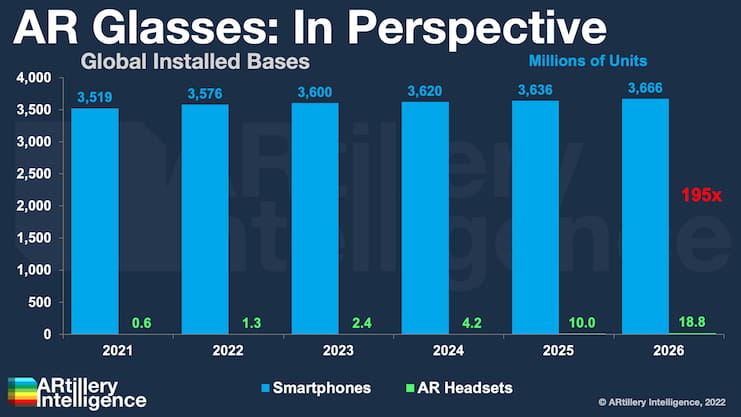
In our daily news skim, we’re often surprised at the volume of editorials in large and small publications, espousing a near-term future laden with AR glasses. This breathless future gazing often fails to stop and examine the real challenges and years of development to get there.
For example, if we’re to look at AR glasses sales today as a starting line, they are in the thousands, not millions, according to our research arm, ARtillery Intelligence. Smartphones by comparison – a frame of reference for ubiquity – have a global installed base around 3.6 billion.
This pessimistic reality check may sound strange coming from a publication with AR in its title. And indeed we’re bullish on a long-term future for headworn AR (and mobile AR in the meantime). But the key term is “long.” We’re years from ubiquitous all-day wearable AR glasses.
Masochistic Endeavor
One fundamental challenge facing AR glasses is underlying tech. There’s a design trade-off between UX and wearability. The other challenge is culture. Getting people to wear things on their faces is a masochistic endeavor. Look what happened with Google Glass’ early consumer run.
This is why everyone’s attention is turned to Apple, to the point of an obsessed daily news cycle. And this isn’t entirely wrong, as Apple could make or break the AR glasses market. It has a track record of mainstreaming emerging tech, including smartphones, tablets, and smartwatches.
But we often forget that even these tech revolutions happened like most revolutions do… slowly. the iPhone took until the iPhone 4 to inflect towards ubiquity. Airpods and watches likewise took several years to break into the tens of millions in annual unit sales. All these devices started slow.
If that was the case with devices you put on your wrist and in your pocket, extrapolate the cultural learning curve and acclimation cycles we’ll see for anything proposed to go on your face. Just like VR mainstream penetration, this will be a more of slow burn than a wildfire.
In Perspective
Speaking of VR, and backing up for a second, what could Apple’s XR road map look like? Signs point to a VR-like device that offers immersive entertainment experiences and signature Apple elegance. Like Meta’s Quest Pro, it could feature passthrough AR as a bridge to AR glasses.
Those AR glasses could come years later in the circa-2025 timeframe or later. It’s that later play that could have the effect noted above in gradually mainstreaming faceworn AR. And it could indeed inflect the AR glasses market. But in fairness, inflecting that market won’t require a lot.
To quantify that, if Apple launches AR glasses in 2025 and sells 4 million units (close but less than first-year sales for other wearables), it would immediately have a 60 percent market share. This would bring AR glasses’ installed base (different than annual sales) to about 10 million units.
And that brings us back to the comparison to smartphones. Though Apple would inflect the AR market right out of the gate, leading to a projected aggregate installed base of almost 19 million units by 2026, it would still be dwarfed by the smartphone installed base by about 195-1.

Starting Point
Adding additional headwinds to AR glasses growth, we continue to see stumbling blocks. The latest is Google Glass. Though it’s the brunt of AR glasses jokes, it had a fairly successful run in enterprise sales over the past half-decade. Still, Google recently killed the device.
Microsoft HoloLens is another beleaguered entity in the AR glasses world. This included internal issues such as the high-profile departure of HoloLens lead Alex Kipman. It also includes challenges with its big U.S. Army contract and some layoffs that impacted XR divisions.
So for consumer AR glasses to move forward, they may need to take a step back. In other words, the near-term realistic design approach will likely include “lite AR.” This involves a graphically underpowered UX in order to achieve some semblance of style and wearability.
The play there will be designs that are experientially meaningful if graphically underpowered. Fortunately, that’s what Apple does best. This translates to elegant integrations with other wearables, or making you a more functional human. Look for that potential starting point.






